Nearly five years ago on October 27, 2008 Clayton Christensen and Michael Horn briefed participants at an American Enterprise Institute [AEI] meeting on “Disruptive Innovation in Education and Health Care.” Christensen and his work were well known by this Washington DC group. AEI described the meeting:
The ability of technology to “disrupt” long-established business practices–dramatically changing the landscape of industries by increasing access, cutting costs, and revolutionizing delivery–has been a subject discussed for decades and is the topic of Harvard Business School professor Clayton M. Christensen’s iconic volumes, The Innovator’s Dilemma and The Innovator’s Solution. Yet, as Christensen has observed, these radical, innovation-driven transformations have been largely absent in the education and health industries–perhaps the two most important arenas of everyday life.
At that time of the AEI briefing, Christensen and Horn’s book Disrupting Class had just been published. Subsequently, their work has been interpreted by some in the press as resolving the problems of students’ access to (in both a physical and economic sense), and success in, higher education. Christensen and Horn’s presentations and the discussion focused on “online learning”. It should be noted that data from MOOCs [Massive Open Online Courses] would not be available for three more years. Both presentations were far more nuanced than reported.
The press, governments, public and some college leaders assume their model describes what can be achieved by higher education in a few years.
According to Wikipedia, MOOC was a term first used by Dave Comier of the University of Prince Edward Island and Bryan Alexander of the National Institute of Technology in Liberal Education, in 2008. The course to which the term was applied was authored by George Siemens of Athabasca University and Stephen Downes of the National Research Council (Canada) and was offered by the University of Manitoba. “Massive Open Online Courses” had emerged from Open Education Resources initiatives and drew on a history of distance learning. In terms of MOOCs and OER, “open” means free to access and use, whereas “open” in open universities means anyone can be a student.
In 2011 Stanford Professor Sebastian Thrun offered a 160,000 student MOOC on artificial intelligence. Coursera and others soon followed. MOOC success—as measured by enrollments and successful completion by some students—led to the popular understanding of MOOCs and their potential.
“Soon Sebastian Thrun launched Udacity and Daphne Koller and Andrew Ng lauched Coursera, both for-profit companies.” (Wikipedia: Massive open online course).
On July 29, 2012 Coursera, a company that works with more than 80 universities, held a “massive open cookout” for more than 650 potential students, faculty, the press, venture capitalists and others. The Chronicle of Higher Education’s Jeff Young reported:
L. John Doerr, a venture capitalist at Kleiner Perkins Caufield & Byers who is well-known in Silicon Valley, attended the cookout, and said he is an enthusiastic supporter of the effort (he’s also on its board of directors).
I think this could be big the way Google was,” he said. “It’s doing something very, very valuable for free, so it’s going to scale to be enormous.
Both [Coursera’s Andrew Ng and Daphne Koller, a Stanford professor, wearing blue T-shirts with the company’s logo], stressed that their company is meant to be a form of “social entrepreneurship,” and Ms. Koller describes the company’s goal as a kind of social movement.
“MOOC Mania” (as it was later labeled by The Chronicle’s Katherine Managan) began based on the promise of “disruptive innovation.” Christensen and Horn’s work and the MOOC success had been linked together with all of the promises that accompany innovation.
The Christensen “Disruption”
In Disrupting Class Christensen and Horn write:
All disruptions share a pattern, Disruptions [from new technology] first compete against nonconsumption [of old technology] …The technology improves and the underlying cost declines. …
But this transition is neither abrupt nor immediate. When a new approach or technology substitutes for an old one because it has a technological or economic advantage over the old, the substitution pace almost always follows an S-curve, as depicted on the left side of [Figure 1].
Two graphs from Horn’s AEI presentation are shown in Figure 1. The left graph is the number of students taking online courses. The right graph shows ratios between the users of new technology to old technology plotted on a logarithmic scale. Their model is considered “disruptive” if the data, plotted on a logarithmic scale, is linear. Numbers of users of the new technology create the S-curve. The angle of the data line represents how fast conversion to new technology from old technology takes place. The nearer vertical the faster the conversion.
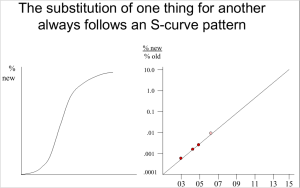
According to their model, initial users of the new technology cause or convince users of the old technology to change. In the beginning there are few new users and many using the old technology. As the number of new users accumulates over time, they facilitate an increasing conversion of new users of the technology. When one-half are using the new technology, there are fewer remaining users of the old technology that can change and the rate of conversion declines.
The second graph in Figure 1 is used to forecast the first. If the S-curve is an appropriate model, then the ratio of users of the new technology to users of the old over time is extended linearly. The accumulating number of new users creates the S-curve. Percentages are used since there are other factors, such as changes in total enrollment. Here the percentage of new users is used as a multiplier of total enrollment to show the number of students that use the new technology.
Notice the comment that “Disruption” reduces cost—a point many in the public assume will resolve higher education’s financial issues. The Chronicle of Higher Education’s Steve Kolowich wrote:
Those stalled efforts to push MOOCs through the institutional membrane that surrounds higher-education credentialing have cast doubt on whether large-scale free courses will end up disrupting anything.
In 2008 Christensen and Horn were not claiming disruption was happening, but rather were saying online learning may be disruptive. However now Horn, a co-founder of the Clayton Christensen Institute for Disruptive Innovation says: “As you go in the belly of the beast, you will run into this brick wall every single time.” Neither Kolowich or Horn were specific about the ”brick wall.” Possible barriers is a different discussion.
Christensen’s remarks at the AEI briefing pointed out one market entry strategy is to have a lower-cost product with fewer features and functions than other products. As their market expands then incorporate these features and functions into later version of the product. It is this discussion that led many to assume online learning would have a lower cost. However higher education is a closely regulated industry with quality defined by the U.S. Department of Education.
In Disrupting Class Christen and Horn wrote, based on their model of disruption and available data, 50% of grade 9 through 12 students would be taking online courses in 2019 (Figure 4.2 in Disrupting Class). They assumed the disruption began in 2001—when data became available—and had data from the first five years of experience. They were using data from the North American Council of Online Learning for grades 9-12. They write:
Not much change is on the horizon if one projects linearly into the future. But when viewed from the [S-curve] logarithmic perspective, the data suggest that by 2019 about 50 percent of high school courses will be delivered online. In other words, within a few years, after a long period of incubation, the world is likely to begin flipping rapidly to student-centric online technology.
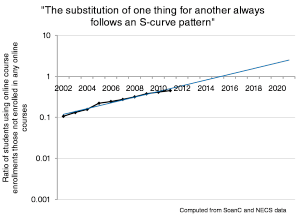
Beginning in 2002 data from the Sloan Consortium of the number of online students in higher education taking online courses became available (see Figure 2). Only the first four years were available when Christen and Horn wrote Disrupting Class. The ten years of data now available show 50% of the students—the ratio of new to old is 1—to be taking online courses in 2015 or 2016. In 2011—the latest date data is available—31.1% of college and university students were users of online technology.
The close relationship between actual data compared to projected data validates the use of the S-curve model of disruptive innovation. Data from the first few years is sufficient to create a projection that should be relatively accurate though changing conditions can impact the projected number of students taking online courses.
Christensen and Horn’s model called this process the substitution of “computer-based learning for monolithic learning.”
If no changes were made on the conversion rate, Horn’s projection would take 18 years for 50% of grade school and middle schools students to be using online courses. Similarly the SloanC data suggests 13 or 14 years for higher education to reach 50% from their 2002 use. The low angle of the ratio from the right graph of Figure 2 suggests the increase in number of student taking online courses will change slowly (twenty years to reach 80%). Compared to consumer goods, this is a lengthy period of implementation and the S-Curve becomes closer to a simple growth projection.
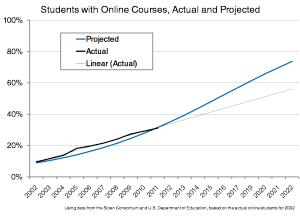
A simulation of the S-curve is shown in Figure 3 for SloanC data. The actual experience began with online students in 2002 using 9.6% from earlier enrollment growth. The model shown begins with this number and reaches the midpoint between 2015 and 2016; the linear continuing growth projection does not reach the midpoint until 2019 or 2020. The curve of projected blue line shows the increasing conversion of users from old to new technologies.
The actual enrollments and values projected from 2002-2004 data, converted to enrollments, are also shown in Figure 4.
The rate of conversion—number of users of the new technology converting the number of users of the old technology, also sometimes referred to as a diffusion rate of new technology, can be increased through improved communication. Three conversion rates were simulated in Figure 5 to show the effect of changes. The current and projected total enrollment in higher education is also shown.

Wikipedia defined sustaining innovation as an alternative to disruptive innovation:
“a sustaining innovation does not create new markets or value networks but rather only evolves existing ones with better value, allowing the firms within to compete against each other’s sustaining improvements. Sustaining innovations may be either “discontinuous” (i.e. “transformational” or “revolutionary”) or “continuous” (i.e. “evolutionary”).
MOOCs and Disruptive Innovation
As MOOC Mania began, these systems captured the imagination of the press. They began publishing a tsunami of press releases that reported more students (Coursera : 4 million) were enrolling and more “universities” (Coursera : 84 and counting) were offering online courses.
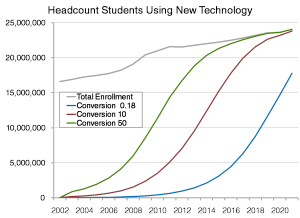
So far, MOOCs are offered to students for free, though there may be optional fee-based services. No business model for MOOCs has yet been adopted that yields adequate return on investment (ROI) for their investors, or break-even for universities and colleges offering their own MOOCs.
MOOC providers transferred the responsibility for paying for course content, implementation, and, in some cases, limited faculty support for students, to the sponsoring universities.
Online courses are a major investment; high quality learning materials are expensive with estimates of $600,000 to $1 million per course. Open University UK spent US$1 billion to develop the courses for their three-year bachelor’s degree. Grants to faculty members are often inadequate. The facilities and specialized staff to produce high quality learning materials are not available to most faculty.
Since the university providing the materials is identified, the universities also provide a “brand” implying quality of the courses. There is “reputation risk” if the courses do not meet expectations for quality.
Andy Kessler of the Wall Street Journal described possible cost savings. He reported on Sebastian Thrun’s Stanford University CS221 Introduction to Artificial Intelligence course saying: “[Sebastian] Thrun’s [unit] cost was basically $1 per student per class.” As the divisor—160,000 student enrollments in this case—“massive” leads to lower unit costs. To reach breakeven with high quality full-credit online courses, Open University UK’s [OU-UK] Vice Chancellor (CEO) Sir John Daniel thought a mega-university would need enrollments of 100,000 or more to be economically viable because of the investment in course materials and infrastructure. OU-UK currently enrolls more than 240,000 students.
Now Sebastian Thrun has a more subtle interpretation of his experience. The Chronicle of Higher Education quotes Thrun on MOOCs:
A medium where only self-motivated Web-savvy people sign up, and the success rate is 10 percent, doesn’t strike me quite yet as a solution to the problems of higher education,”
MOOCs did show workers—many with college degrees in rapidly changing fields— did need and would participate in an available learning experience. Their learning should increase the rate of innovation in those industries, the basis for increasing economic productivity. MOOCs also showed that students quickly self-select based on the relevance of the course to their interests, the effort required, and their own capability to accommodate the work associated with the course.
Although MOOCs have made public and government officials aware of online learning, the results do not yet show MOOCs are a “Disruptive Innovation” that will resolve issues of access and costs, at least not as fast as governments and the public expect.
The Realities of Online Learning
Although MOOCs are considered the “new technology” from Silicon Valley, online learning has a long history and extensive use both to replace and supplement traditional classroom instruction.
For several years, U.S. colleges and universities extensively and effectively provided credit and non-credit online courses. The first online for-credit course was offered by Stanford University for the 1966-67 school year. At that time Principal Investigator Patrick Suppes predicted 15% of colleges and university students would be taking online courses by 1980; this actually occurred in 2005.
Computer-aided instruction, as it was called in the 1960s, has proved difficult to implement. Research continues on barriers identified by Suppes to the effective and productive use of the learning technology. The expense of quality course development continues to be a major barrier at a time of fiscal stringency.
Now more and more students are electing or preferring to take courses in an online format. For the past decade the growth in students taking online courses has consistently exceeded the growth of enrollments, as shown in Figure 6. (The National Center for Education Statistics has forecast a decline in opening fall enrollment for 2012 and recovery in 2013 based on fewer high school graduates in 2012). The chart shows the combination of increased enrollment and the percentages of student with online courses combine to increase online enrollments at 14.1% per year.
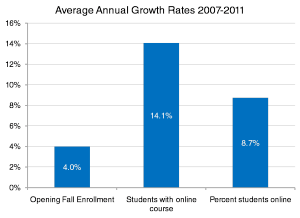
Average annual growth rates for the past five years, academic years 2007-08 through 2011-12 are shown in Figure 6. Open fall headcount enrollment increases an average of 4.0% per year with 2011 being reported as 2.8%. The average annual growth rate of students enrolled in one or more online courses for the same period is 14.1% with 2011 being reported as 9.3% following a peak of 21.1% in 2009.
Reviewing historical progress, the cumulative growth for the past five years is shown in Figure 7.
For this period the cumulative opening fall enrollment has increased 21.6 %, the percent of students with online courses increased 58%, and the increase of students taking online courses was 92.5%.
The reality of online learning, as measured by the number of students taking an online course, is a substantial increase even in years of financial pressures on enrollments. Colleges and universities have expanded the number of online courses and enrollments using faculty and staff with limited resources. A major achievement. The experience and knowledge, and implementation skills of these campus teams have largely gone unrecognized by the governments and public.
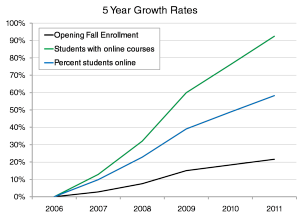
But this transformation has now provided experience and expertise, infrastructure, and techniques for developing effective learning materials. The infrastructure for online learning is maturing. Available course materials of increasing quality are expanding.
Some consolidation of online learning, as suggested by the open universities and the recommendations of the Chief Information Officers of the Committee for Institutional Cooperation, could create sufficient scale to achieve significantly improved learning, increased student performance, and lower unit costs.
A big challenge with big rewards.
[…] MOOCs: A Disruptive Innovation or Not? (mfeldstein.wpengine.com) […]